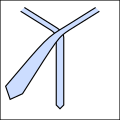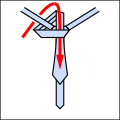| Four-in-hand knot | |
|---|---|
 | |
| Names | Four-in-hand knot, Simple knot, schoolboy knot, cravat knot |
| Related | Buntline hitch |
| ABoK | #2408 |
The four-in-hand knot is a method of tying a necktie. Also sometimes known (in UK) as a Bucket Knot, due to the shape of the finished knot. Some reports state that carriage drivers tied their reins with a four-in-hand knot, while others claim that the carriage drivers wore their scarves in the manner of a four-in-hand, but the most likely etymology is that members of the Four-in-Hand Club in London began to wear the neckwear, making it fashionable. The knot produced by this method is on the narrow side, notably asymmetric. For United States Army uniforms, and United States Navy uniforms that include a necktie, the four-in-hand knot is one of three prescribed options for tying the necktie, the other two being the half-Windsor and Windsor. [1] [2]



